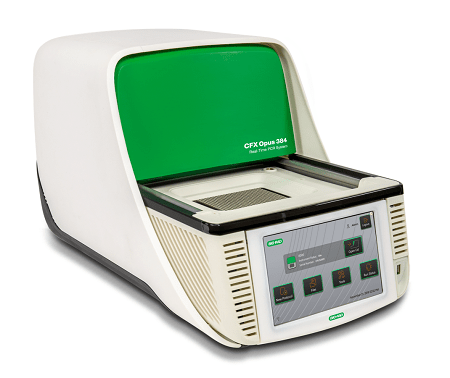Product Review: Bio-Rad Laboratories CFX Opus 96 and CFX Opus 384
In the wake of COVID-19 pandemic, Bio-Rad Laboratories have introduced two highly advanced real-time RT-PCR system, CFX Opus 96 and CFX Opus 384 that provide an efficient experience and optimal results.
The application of a real-time Polymerase chain reaction (PCR) system in the field of molecular diagnostics has become a standard method for identifying nucleic acids from collected microbial samples. The real-time PCR (also known as RT-PCR) systems are sensitive, rapid, precise, and minimize the risk of contamination while being employed for various research procedures such as detection and expression analysis of genes, quantitative genotyping, early diagnosis of diseases, forensics, etc. Ever since the introduction of RT-PCR, the technology is just getting better with each medical innovation. The COVID-19 pandemic has put RT-PCR in the spotlight as it is considered the most accurate and efficient testing method for the detection of the SARS-CoV-2 virus. The use of RT-PCRs has been tremendously expanding for the testing of novel coronavirus and the demand is likely to grow due to the rising incidences of infectious diseases.
Recently, Bio-Rad Laboratories introduced the next generation of the company’s CFX real-time PCR systems, CFX Opus 96 and CFX Opus 384, that offers improved connectivity and high performance. The sleek and modern CFX systems bring forth the next revolution in qPCR with their easy-to-use interface and advanced connectivity options. Both the RT-PCR systems are ideal for basic and translational research, genomic testing, quality control, process development, detecting infectious diseases, as well as pathogen detection. Along with expanding Bio-Rad Laboratories’ portfolio of CFX products, the company also launched cloud-based instrument connectivity and data management system, BR.io.

Consolidating an accurate optical shuttle system and improved thermal performance, the new CFX systems are designed to provide more consistent data than ever. The advanced RT-PCR systems are capable of performing stand-alone operations, which makes them indispensable as life-research tools for diagnostic interventions. The systems show excellent compatibility to ethernet as well as Wi-Fi, and thus enable completely wireless operations and data management. The user can transfer the retrieved data by connecting the CFX systems with a PC or via direct data transfer to a USB device. In network-connected locations, the CFX Opus system can be programmed to send the data as well notifications directly to your email or local drive, and thus the updated systems deliver an efficient experience to RT-PCR users.
Bio-Rad Laboratories’ CFX Opus 96 has five color detection formats whereas CFX Opus 384 RT-PCR provides four color detection formats. The sensitive and modern touchscreen of the systems is responsive even with double gloves and more intuitive than previous generation CFX systems. However, the uniform optical system does not have regular calibration requirements, which saves time and effort. Additionally, the products’ block design delivers tight thermal uniformity during the real-time PCR experiments.
Shuttle Optics Technology
The newly launched CFX Opus systems retain many features of the previous generation models that researchers and scientists liked. Both the systems have been built upon the same proprietary optical design, employed across the company’s portfolio of CFX products, however, the latest ones are easy to set up and install due to improved capabilities and flexible connectivity options. The device manufacturer has put efforts in making the design of the CFX system sleek and modernized, for which they have transcended from a clamshell lid to a retracting version, which allows the RT-PCR to be used in even more spaces than before. Despite the design modifications, the updated system looks somewhat familiar to previous systems, but they are more convenient.
The CXR Opus systems incorporate shuttle optics technology that utilizes the same excitation-detector pair just like other systems in the Bio-Rad Laboratories’ RT-PCR portfolio. In the new systems, shuttling the optics across the plate eliminates the possibility of variability that may result from detectors. Besides, the technology reduces the need for correction in detector angle arising from a single fixed camera. The consistency of the device is further augmented with the significant development in thermal performance, which provides uniformity of ±0.3⁰C and accuracy of ±0.2⁰C. Both the shuttle optics technology and the high-performance thermal gradient work brilliantly together and produce consistent and reliable results.
CFX Maestro Software
The CFX systems come with an updated and full-featured CFX Maestro Software, that is easy to use and learn. The software allows users the ability to perform statistical analyses of gene expressions and find solutions to complex biological questions. Also, the user can make an analysis without exporting the retrieved data into a PC with the help of Maestro Software. The software also consists of a Laboratory Information Management System (LIMS) integration, application programming interface (API), and other functions for more advanced users.
BR.io cloud platform
Bio-Rad Laboratories has expanded the family of life science tools with the addition of the BR.io cloud platform, which provides users a simplified qPCR experience. The cloud connectivity platform incorporates in CRX Opus systems provides a robust solution to meet the needs of the customers in the expanding field of genomics research and diagnostics. Leveraging BR.io, the users can retrieve remote data with any internet-connected computer as well as monitor registered instrument status, thus the cloud connectivity ensures efficiency and provides enhanced versatility in operations. You can connect to the CFX Opus systems to the BR.io cloud platform through an Ethernet connection or with simple Wi-Fi connectivity and access local network file drives for which your institution has granted access. Thus, BR.io provides seamless data transfer, enable users to access data anywhere from the cloud, design experiments, and analyse data.
Latest Additions in RT-PCR systems
Azure Cielo 3 Real Time qPCR System
Launched in June 2020, the Azure Cielo real-time PCR system is a 96-well qPCR machine dedicated to genomics workflow. The new RT-PCR system delivers a high-performance and provides intuitive workflow due to its innovative optical design. The device assures sensitivity and reproducibility with optimal excitation reaction utilizing single-well excitation and emission. The system features a 10.3” touch screen interface that makes setting up and checking status easy. Data from the compact device can be retrieved via USB, ethernet, or Wi-Fi in a connected environment. The RT-PCR device comes with Azure Cielo Manager software that offers a comprehensive workflow solution and enables accurate analysis. Azure Cielo qPCR is a user-friendly and precise instrument that generates good reproducibility and enhances the productivity of researchers by automating sample extraction, amplification, and detection in one cartridge.
Palm PCR S1
Ahram Biosystem has developed an ultra-fast mobile real-time PCR system that allows one to instantly complete PCR tests anywhere and anytime without any electricity, or communication. A brilliant innovation in RT-PCR systems, the Palm PCR S1 is considered the future of biotechnology. The mobile device is extremely efficient and convenient, which can deliver results in less than 12 minutes with high accuracy even with a single copy target concentration. Powered with convection PCR technology, the ultra-fast system has a maximum of six real-time channels available, thus the full capacity of the device can be achieved without detectable crosstalk. The standalone device consists of a lithium battery that enables four hours of continuous operation and can be operated at temperatures up to 40 degrees Celsius. The device can be easily connected with a PC via Bluetooth and Wi-Fi.
Conclusion
Recognizing the importance of molecular diagnostics for the detection of pathogens responsible for infectious diseases, many biotech companies are coming up with innovative RT-PCR systems. Standardization and quality control have remained some of the major limitations of diagnostic PCR, but the new methodologies and technologies are utilizing artificial intelligence to reduce the need for human input. PCR diagnosis is likely to have a huge impact on the customization of healthcare and the development of drugs in the coming years.
According to TechSci research report on “Global dPCR and qPCR Products Market By Technology (Quantitative, Digital), By Product (Consumables & Reagents, Instruments, Software & Services), By Application (Clinical (Pathogen Testing, Blood Screening, Oncology Testing, Others), Research, Forensic, Others), By End User (Hospitals and Diagnostic Center, Research Laboratories and Academic Institute, Pharmaceutical and Biotechnology Companies, Clinical Research Organizations, Forensic Laboratories), By Region, Forecast & Opportunities, 2025″, the global dPCR and qPCR market is estimated to register a significant CAGR owing to rising incidences of infectious diseases as well as increasing application of biomarker profiling for disease diagnostics. Moreover, introduction of technological advancements in PCR technologies and high costs of advanced PCR devices might hinder the growth of dPCR and qPCR market.
According to another TechSci research report on “Global Real Time PCR Market By Product (Instruments, Reagents & Consumables, Software & Services), By Application (Clinical (Pathogen Testing, Blood Screening, Oncology Testing), Research, Forensic, Others), By End-user (Hospitals & Diagnostic Labs, Research Laboratories & Academic Institutes, Pharma-Biotech, Clinical Research Organizations (CRO), Forensic Laboratories, Others), By Region, Competition, Forecast & Opportunities, 2025″, the global real-time PCR market is expected to grow significantly due to increasing advancements in PCR techniques and introduction of funds and grants by government and healthcare organizations across the globe.



